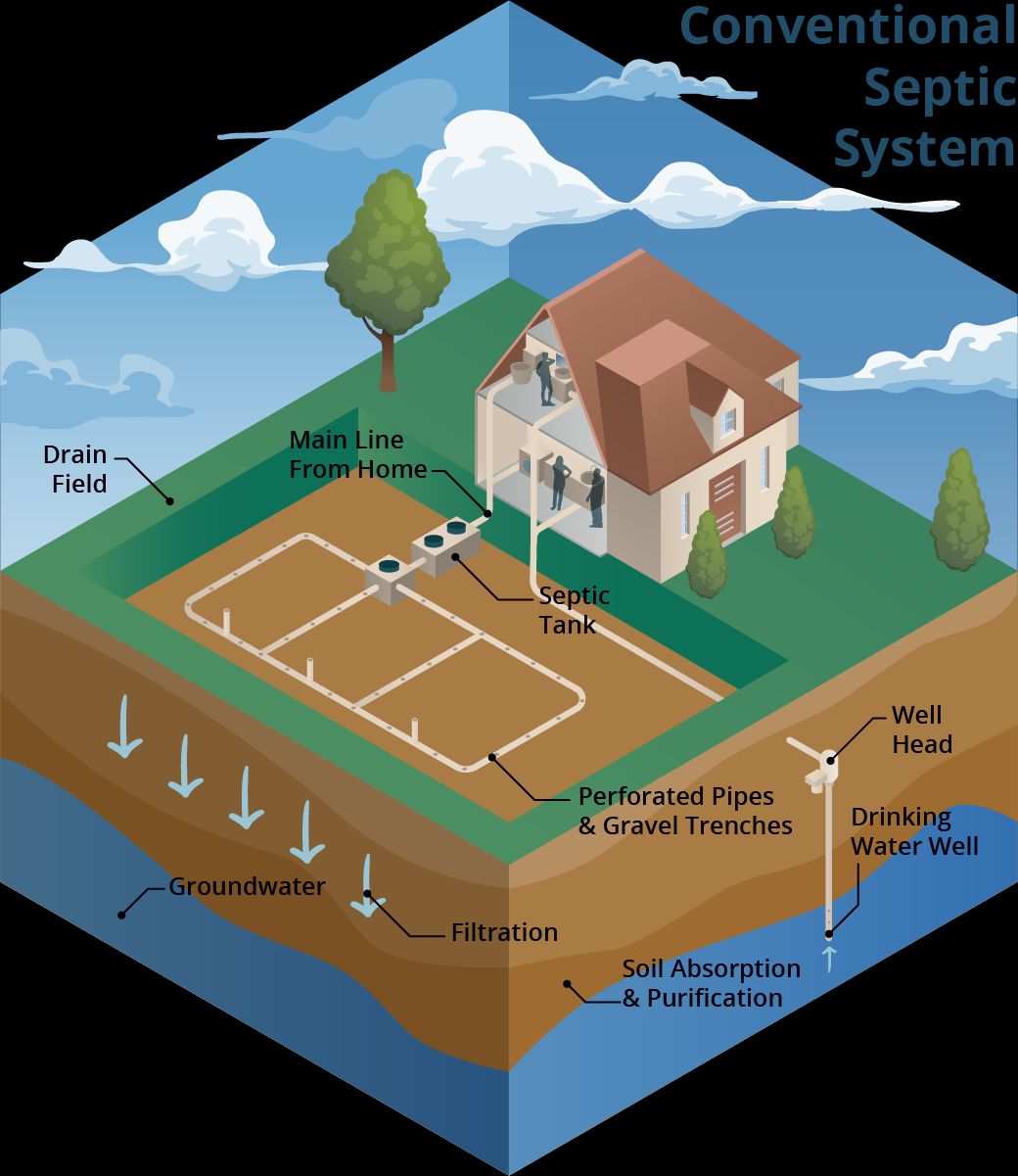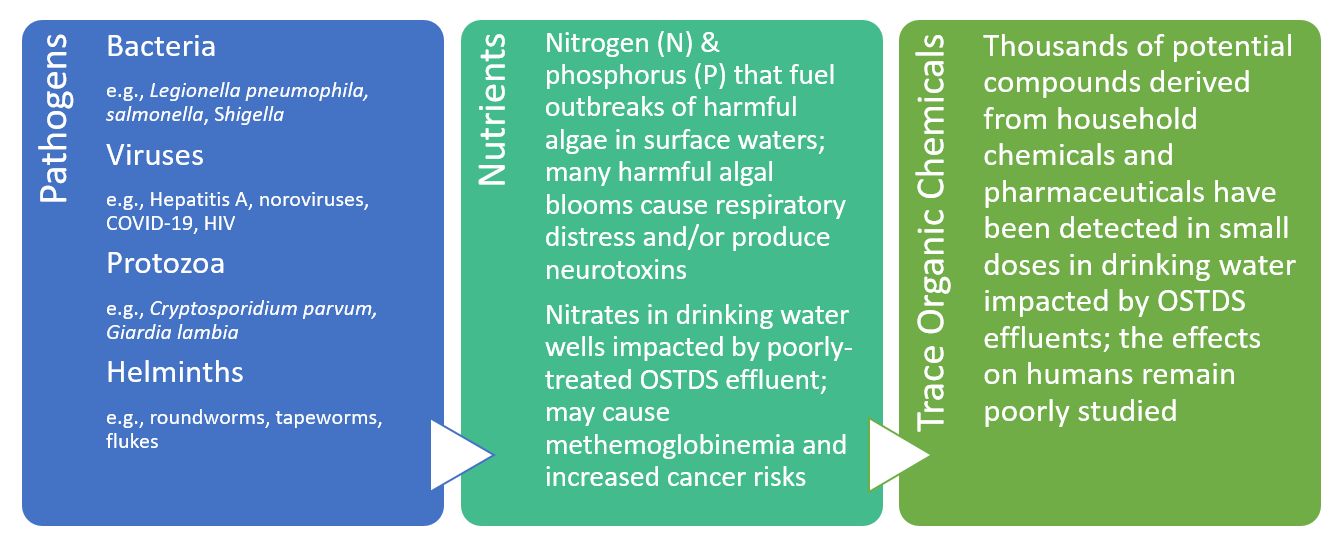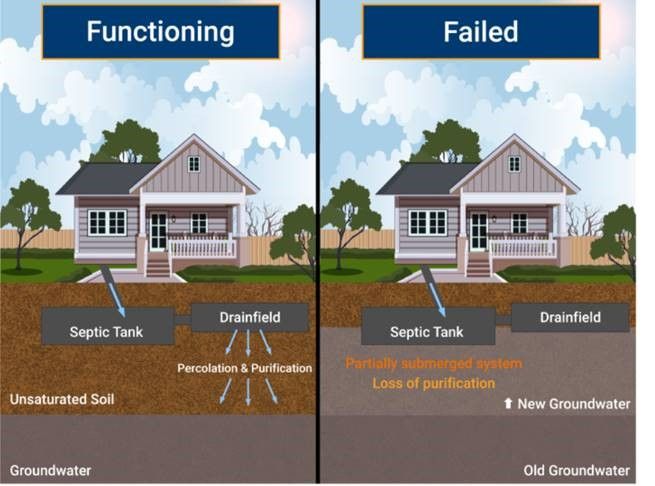Purpose and Introduction
The purpose of this publication is to explain how septic systems may be affected by floods from hurricanes and other storms and/or by climate change (sea-level rise) that raises the level of the groundwater under septic system soils. While this publication is intended primarily for homeowners and renters with a septic system, it can also be a helpful guide for state and county planners and decision makers as they work toward building climate change resiliency in their municipalities. A glossary of terms is provided at the end of this publication to clarify the technical terminology commonly used to describe septic systems and their impacts on the environment.
The safe treatment of domestic sewage is necessary for protecting human and environmental health. Domestic sewage is the wastewater generated by homes and apartments, which includes all the wastes from toilets, bathtubs and showers, laundry and dishwashing appliances, and sinks. It contains numerous pollutants of concern to both people and the environment, including disease-causing pathogens, nutrients that may lead to algal blooms in our water resources, and other potentially harmful chemicals from substances such as household products and pharmaceuticals that enter the waste stream through disposal into sinks and toilets or that pass through the human body in feces or urine.
Domestic sewage is treated by several methods. The two most common means of sewage treatment in the United States and many other countries are by household connection to a wastewater treatment plant (sometimes called a central sewer plant), or by an onsite sewage treatment and disposal system (often called a septic system). A septic system in a self-contained underground sewage treatment unit typically contains a chamber called a septic tank where household wastes accumulate, and a soil area called the drainfield where liquid effluent that leaves the septic tank percolates downward. As septic tank effluent percolates downward through the drainfield soil, it interacts with soil particles, and many harmful pollutants are thereby degraded, filtered out, and removed (Toor, Lusk, and Obreza 2011a; Lusk 2022; Lusk et al. 2017).

Credit: UF/IFAS GCREC Urban Soil and Water Quality Lab
There are more than 2 million septic systems in Florida. Their effectiveness at removing pollutants varies, depending on both environmental and social factors. Environmental factors that affect septic system performance include soil type, depth to underlying groundwater resources, and frequency of flooding or waterlogging. To adequately remove pollutants and pathogens from wastewater, septic systems must be placed in non-waterlogged soils and have sufficient space between the bottom of the drainfield and the groundwater surface. A sufficient depth is normally at least 60 cm. Social factors that affect septic system performance include how often the system is pumped and otherwise maintained, the number of people in a household, and the amount and type of waste a household generates. Recommendations for septic system upkeep and maintenance can be found here.
Regardless of how well you maintain your septic system—including having it pumped on a regular basis—certain environmental factors can keep it from adequately treating and removing pollutants from the sewage your home produces. For example, in Florida’s vulnerable springs ecosystems, even the best-maintained septic systems may contribute nitrate pollution to groundwater and be one cause of water quality deterioration (Lusk et al. 2020). More information about how septic systems may affect Florida’s springs can be found here. Frequent hurricanes and floods and the effects of sea-level rise associated with climate change can also affect septic system functioning. This is because septic systems need at least 60 cm of unsaturated soil (i.e., soil in which all of the small open spaces between individual soil particles are not completely filled with water) in the drainfield. In other words, waterlogged soil is especially problematic for septic systems and will hinder treatment and removal of pollutants in the wastewater. Disease-causing bacteria and viruses in wastewater are particularly difficult to remove from septic system drainfields if the drainfield soil is waterlogged by a flood or by rising groundwater caused by sea-level rise.
Potential Pollutants from Septic Systems
Potential pollutants from septic systems include nutrients (nitrogen and phosphorus), which, in excess, can cause algal blooms and fish kills in water resources; pathogens; and organic chemicals. Other resources provide a full discussion of the sources, fate, and removal mechanisms in septic systems for nitrogen, phosphorus, bacteria and protozoa, viruses, and organic chemicals (Toor, Lusk, and Obreza 2011b; Lusk, Toor, and Obreza 2011b; Lusk, Toor, and Obreza 2014; Lusk, Toor, and Obreza 2011a; Toor, Lusk, and Obreza 2011c). Figure 2 provides a brief summary.

Credit: Adapted from Lusk (2022)
What to Do During and After a Flood If You Have a Septic System
Flooding from hurricanes and other storms leaves the soil around septic systems waterlogged and saturated. Coastal areas susceptible to sea-level rise from climate change might have smaller distances from the drainfield to the underlying groundwater. Both situations (flooding and rising groundwater levels) reduce the capacity of the drainfield to adequately treat septic system wastes and remove harmful pollutants. Below are a few guidelines for your septic system during and after a flood.
Reduce water use in your home so you relieve some of the pressure on your septic system. If you have a septic system, most likely all water used in your home (toilets, sinks, shower, appliances, etc.) goes to the septic system. By reducing the amount of water you use during a flood situation, you can reduce the amount of waste that needs to be treated in your septic system.
Do not dump floodwater into sinks or toilets. When you clean out floodwater from your home, dispose of it outside of the home, not in sinks and toilets, where it will just go the septic system and add to the burden of waste that the system must deal with during the flood.
Do not drive heavy equipment or vehicles over your septic system drainfield. It is a good idea to avoid doing this at any time, but it is especially important during a flood. Wet, waterlogged soil can be easily compacted, which will reduce the ability of septic system effluent to drain through it.
Do not open or pump your septic system tank while the soil is still saturated. Wait until the floodwaters are gone before you open your tank to inspect or pump it. Opening the tank while the soil is still waterlogged will allow mud and soil to get into the tank, which will reduce the system’s ability to properly treat wastes.
Look for signs of damage to your system and contact a septic system professional if needed. If you see that your septic system has settled, never drains properly, or has continuously soggy soil around it, or if wastes are backing up into the home, contact a professional for repairs as soon as possible.
Consider testing your well water for pollutants. If you also have a drinking water well on your property, it is likely that the flooded septic system added pollutants to your drinking water. You can contact your county health department for information about how to have your drinking water from a private well tested after a flood. You can also use the information on well testing found here.
Sea-Level Rise Considerations for Septic Systems
Climate change may lead to sea-level rise in many coastal areas that have septic systems. In this case, the sea-level rise will cause groundwater levels to rise and diminish the zone of waste treatment in septic system drainfields (Figure 3). If you live in a coastal area or other area that is expected to be impacted by sea-level rise, be sure to ask your septic system professional to inspect the depth to the water table every 2–3 years. You want to maintain at least 60 cm (24 inches) of unsaturated soil in your drainfield for adequate pollutant removal from septic system effluent. If you have less than this, you may need to consider replacing or remediating your septic system with technology to improve its efficiency. You can talk with your county health department for more information about alternatives to conventional septic systems.

Credit: Isabella Wehner, UF/IFAS GCREC Urban Soil and Water Quality Lab
Other Resources
UF/IFAS Extension has several online resources to help you understand how your septic system works and how to keep it working at its best. Below are other resources you may find helpful.
UF/IFAS Water Programs, Information on Septic Systems: Fact sheets and other information on how septic systems work, how to maintain septic systems, and their connections to water quality.
Private Well and Septic System Series: A collection of videos and blog posts with tips for maintaining your septic system and guidance on how septic systems may affect the quality of water from nearby drinking wells.
Glossary of Terms
Flooding: The covering of normally dry ground with a large amount of water.
Groundwater rise: The upward movement of the water table (the level below which the ground is saturated with water) due to changes in rainfall patterns.
Nitrate pollution: Excess nitrate in an ecosystem. Nitrate is a form of nitrogen that can be used by plants and is an important plant nutrient, but when it is present in excess of plant needs, it can be labeled as a pollutant because it can lead to harmful algal growth in waterbodies.
Recurrent flooding: Happens when the flooding effects of rain, storm surges, or tides occur on a regular or frequent basis.
Septic system: A type of wastewater treatment that consists of a drainage pipe, a septic tank, and a drainfield. For homes with septic systems, water drains from a main pipe into a septic tank. Solids settle to the bottom of the tank, and the leftover liquid goes through underground pipes into the drainfield. The soil in the drainfield filters the wastewater, hopefully removing pollutants before the water is discharged to underlying groundwater.
References
Lusk, M. G. 2022. "Public Health Threats of Diminished Treatment of Onsite Sewage.” Lancet Planet Health 6 (9): e707–e708. https://doi.org/10.1016/S2542-5196(22)00191-7
Lusk, M., A. Albertin, W. Elmore, W. Lester, and J. Moll. 2020. “Septic Systems and Springs Water Quality: An Overview for Florida: SS693/SL480, 10/2020.” EDIS 2020 (5). https://doi.org/10.32473/edis-ss693-2020
Lusk, M., G. S. Toor, and T. Obreza. 2011a. “Onsite Sewage Treatment and Disposal Systems: Bacteria and Protozoa: SL350/SS552, 7/2011.” EDIS 2011 (8). https://doi.org/10.32473/edis-ss552-2011
Lusk, M., G. S. Toor, and T. Obreza. 2011b. “Onsite Sewage Treatment and Disposal Systems: Phosphorus: SL349/SS551, 7/2011.” EDIS 2011 (8). https://doi.org/10.32473/edis-ss551-2011
Lusk, M., G. S. Toor, and T. Obreza. 2014. “Onsite Sewage Treatment and Disposal Systems: Viruses.” SL351. Gainesville: University of Florida Institute of Food and Agricultural Sciences. https://edis.ifas.ufl.edu/ss553
Lusk, M. G., G. S. Toor, Y.-Y. Yang, S. Mechtensimer, M. De, and T. A. Obreza. 2017. “A Review of the Fate and Transport of Nitrogen, Phosphorus, Pathogens, and Trace Organic Chemicals in Septic Systems.” Crit. Rev. Environ. Sci. Technol. 47 (7): 455–541. https://doi.org/10.1080/10643389.2017.1327787
Toor, G. S., M. Lusk, and T. Obreza. 2011a. “Onsite Sewage Treatment and Disposal Systems: An Overview: SL347/SS549, 6/2011.” EDIS 2011 (5/6). https://doi.org/10.32473/edis-ss549-2011
Toor, G. S., M. Lusk, and T. Obreza. 2011b. “Onsite Sewage Treatment and Disposal Systems: Nitrogen.” SL348. Gainesville: University of Florida Institute of Food and Agricultural Sciences. https://edis.ifas.ufl.edu/ss550
Toor, G. S., M. Lusk, and T. Obreza. 2011c. “Onsite Sewage Treatment and Disposal Systems: Trace Organic Chemicals: SL352/SS554, 11/2011.” EDIS 2011 (12). https://doi.org/10.32473/edis-ss554-2011